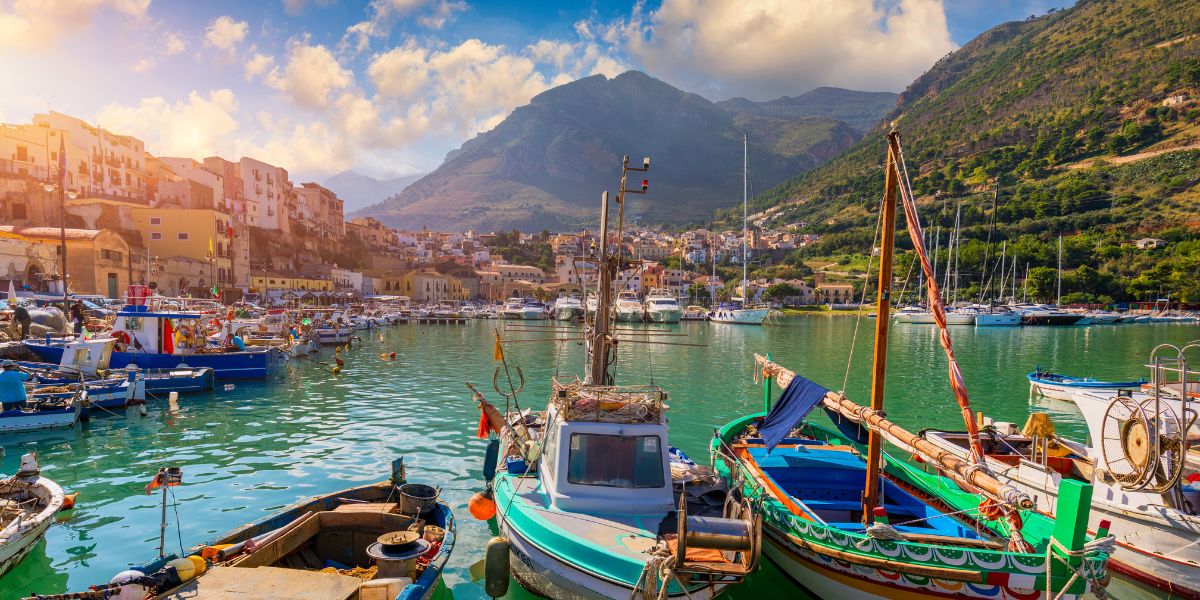Sicily is the largest island in both Italy and the Mediterranean. It’s close in size to the state of Massachusetts. The most famous landmark is Etna, one of the largest active volcanoes in the world. Millions of tourists are flocking to Sicily each year, many heading to Etna. But there is much more to discover beyond the eastern side of the Island. The western part is home to Palermo, the largest city, and Marsala further west. In between there are many wineries to explore. So, when planning a wine tasting trip to this stunning island, #Winetravelers should consider also heading west.
Exploring Palermo and Beyond
Getting Around
To begin your wine tasting journey, start in Palermo, the fifth biggest city in Italy. There are no direct flights to Palermo from North America but most major cities in Europe have direct flights to Palermo. Once in Palermo, the city is accessible by foot and taxi. But to travel around the countryside, a car is needed. Most major rental car companies have offices in Palermo so you can book a car from Hertz, Avis, Enterprise, or SIXT. You can check current rental car rates on Kayak. Driving in Sicily has been made to sound daunting, but once out of the city, it is rather easy. Just be prepared for some narrow roads and cars passing into what seems like oncoming traffic.
Palermo
Palermo’s history dates to the 8th century BC. It was founded by the Phoenicians. Over the centuries, there have been numerous cultural influences that are reflected in the city’s architecture, ranging from Arabic to Gothic.
Things to Do in Palermo
As a large city, Palermo has much to offer. Before venturing out to explore some of the best wineries and wine tasting experiences, it’s worth spending some time in the city itself. There are palaces and churches featuring different architectural styles to visit. There are neighborhoods to stroll through and piazzas and squares to visit, such as the Baroque square Quattro Canti, or “Four Corners”. There is the botanical garden Orto Botanico in the heart of the city and the Museo Archeologico Regionale which features an extensive collection of artifacts from ancient Sicily. But if there is one place to visit that is truly memorable and unique, it is the Catacombe dei Cappuccini (Catacombs of the Capuchins). It is a macabre yet fascinating place featuring 8,000 mummies and skeletal remains that date back to the 16th century. These dead bodies are all dressed up in the appropriate clothes of their era and some are in very good condition, especially Rosalia Lombardo, a little girl who died in 1920 and looks like she is sleeping. It is definitely eerie but worth a visit.
Eating in Palermo
Another thing to do in Palermo is to eat cannoli. The deep-fried cylindrical pastry shells filled with sweetened whipped ricotta mixed with candied citron and grated chocolate can be found in Palermo, Catania, and Messina but many will argue that the best cannoli are in Palermo. Most local opinions will vary on who they think has the best cannoli and you cannot go wrong.
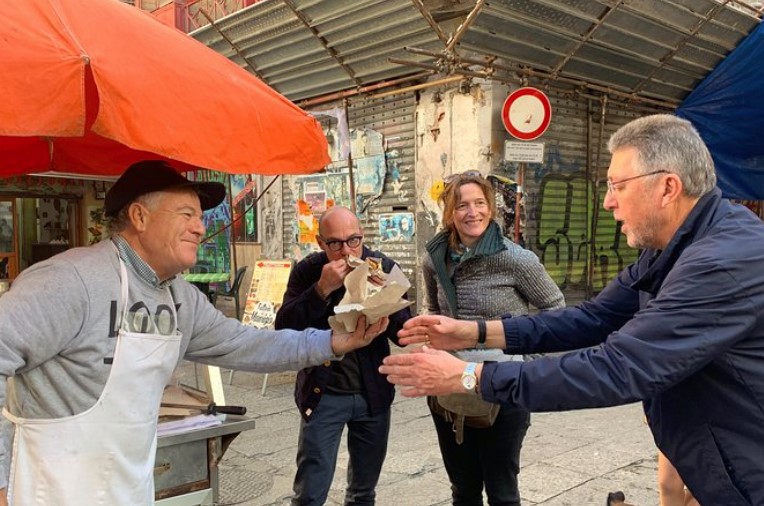
One of the best ways to explore cannoli, and all the other delicious foods of Palermo is a walking food tour. Marco Romeo created Streaty, Palermo’s first city food tour in 2013. Streaty’s mission is to support small family-run businesses and save Italian street food traditions. Groups are small and led by guides who are passionate and knowledgeable. You can book your street food walking tour with Streaty in Palermo right here. They also offer food tours in Catania, Taormina, Naples, Venice, and Florence.
For a seated meal, Corona Trattoria is a standout. A family restaurant, Corona Trattoria is run by brothers Orazio and Alessandro Corona and their parents Gianni and Angela. The restaurant decor is simple but elegant with pictures capturing different elements of Sicilian food and its sources. Corona Trattoria serves fresh seafood and dishes are fresh, delicious, and flavorful. They also have an extensive Sicilian wine selection.
RELATED: Top Wine Tours in Sicily: Etna, Catania & Taormina
Family Vineyards & Wine Cellars Near Palermo
Wine Tasting at Feuda Disisa
SP30 KM 6, 90046 Monreale PA, Italy
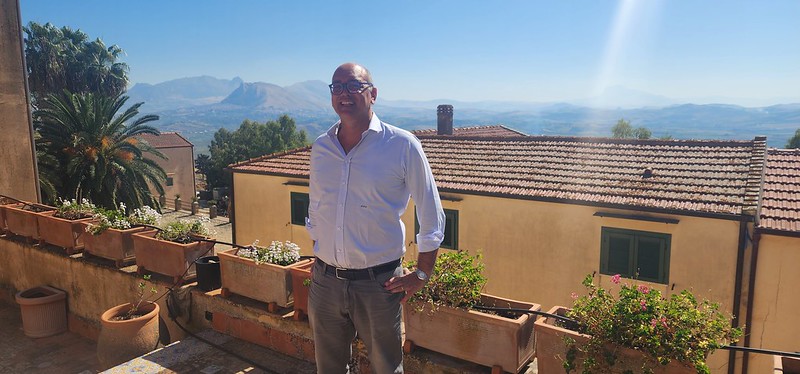
Head west from Palermo to Monreale DOC. Here you will find Feuda Disisa, owned by the Di Lorenzo family. William the Second had gifted the land to the Church of Monreale who owned it for 500 years. Feuda Disisa was one of the estates under the Church of Monreale. The name Disisa is derived from an Arab name (ziza) that means splendid, which aptly suits the beauty of the landscape.
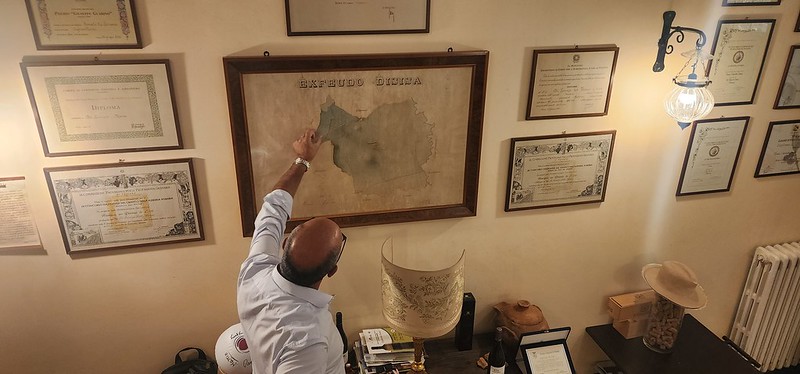
The Di Lorenzo family acquired the property in 1865 and in 1930 the winery was built. For many decades bulk wine was made, but in 1979, the Di Lorenzo family closed the old winery and sold their grapes to the local cooperative. In 1984, owner Renato Di Lorenzo started an experimental vineyard and planted international varieties. For more than a decade, the focus was on international varieties, but by 2000, Renato and his son Mario refocused on indigenous varieties, shifting to an emphasis on quality, not quantity.
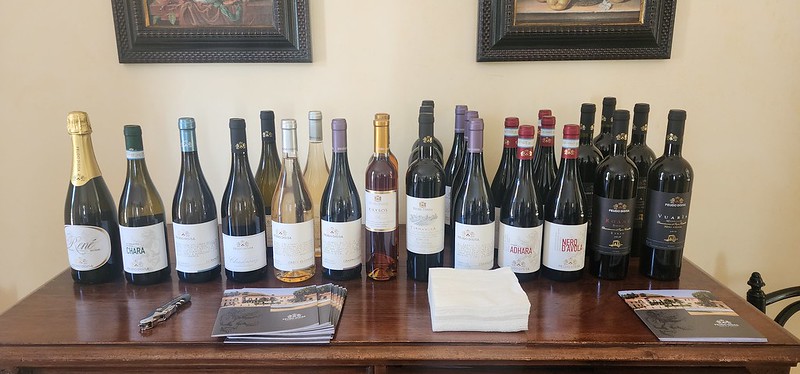
Feuda Disisa started to make wine again in 2004 and built a new winery and visitor center. They have 345 acres of vines planted in the hills and 173 acres of olive trees. While they grow and produce wines from international varieties such as Chardonnay and Syrah, it is the Catarratto and Perricone that shine.
Castellammare del Golfo
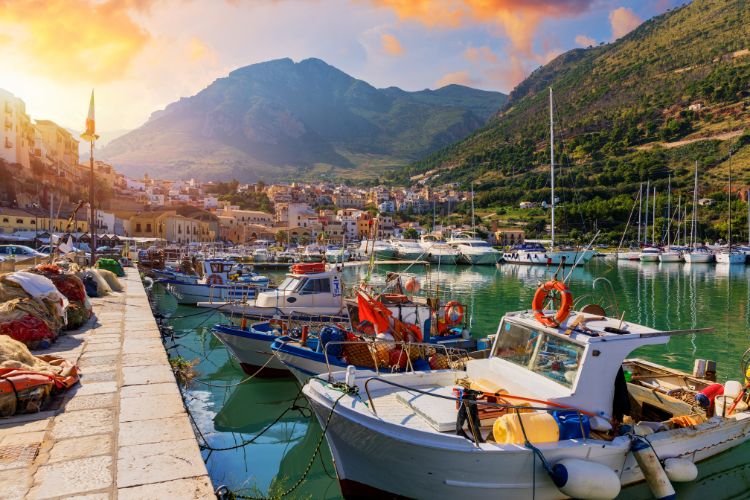
From Feuda Disisa, head 30 minutes northwest to the seaside town of Castellammare del Golfo. Located on the northwestern coast of Sicily, between Palermo and Trapani, Castellammare del Golfo is a historic little fishing port between the Tyrrhenian Sea and steep mountain slopes. Part of the charm of this village is that it is not overrun by tourists.
Castellammare has a curved harbor (Cala Marina) that ends at the castle that watches over the harbor. An Arab-Norman Castle, it is the landmark that inspires the name of the town as Castellammare del Golfo translates to “Sea Fortress on the Gulf”. Along this walkable harbor are bars and restaurants. If there is one restaurant to stop in, it is Ristorante La Tonnara, where you will get the freshest fish. Tonnara (“trap”) are the vast nets that have been used to haul in tuna. The Tonnare were the large fisheries found in Sicily and these former tuna processing centers have been renovated into hotels and restaurants today. Ristorante La Tonnara is owned by Gloria Randazzo and her father Gaspare Randazzo, a fishmonger. Gloria is also a certified sommelier and will happily pair Sicilian wines with fresh fish and other seafood.


Savoring the evening at Ristorante La Tonnara in Castellammare del Golfo. Images courtesy Allison Levine.
Spend a night or two in Castellammare del Golfo at the Hotel Cetarium located in Cala Marina, one of the oldest buildings in the city. The rooms are simple but comfortable, and the location cannot be beaten. While in Castellammare del Golfo, relax at the beach, take a hike in the mountains, or rent a boat and head out on the sea for a swim.
RECOMMENDED: Take a Full-Day Boat Trip from Castellammare del Golfo to San Vito Lo Capo with Mare and More



Taste local wines and enjoy a day on the water. Images courtesy Mare and More.
Wine Tasting at Tenuta Orestiadi
Viale Santa Ninfa, 91024 Nuova Gibellina TP, Italy
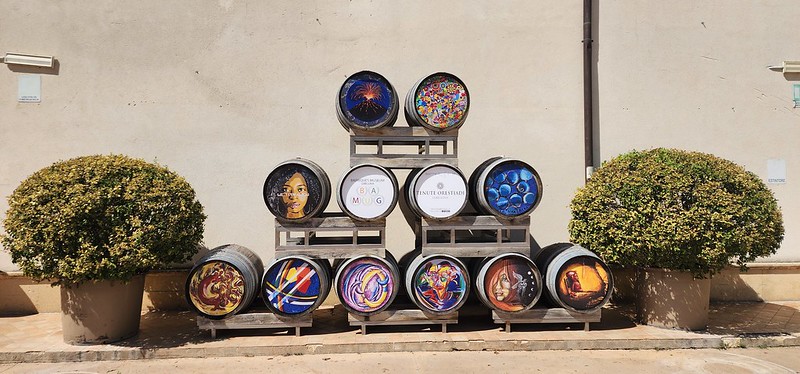
Thirty minutes south of Castellammare del Golfo is the Belice Valley, a small wine-producing area with vineyards nestled among the hills. At the heart of the Belice Valley is the town of Gibellina which was completely destroyed during an earthquake in 1968. The Italian government incentivized people to leave but Gibellina’s mayor Ludovico Correo believed in the area. Along with the farmers who refused to abandon their vineyards, Ludovio rebuilt the town of Gibellina. Gibellina Nuova (the new Gibellina) was built seven miles from the original town. What was also unique is that Gibellina Nuova would be a town centered around contemporary art. There are 67 pieces of art found around Gebellina. One piece is from artist Alberto Burri who enshrined the original town of Gibellina by covering it in plaster. The streets were carved out and visitors can walk through the old town which overlooks the new town.
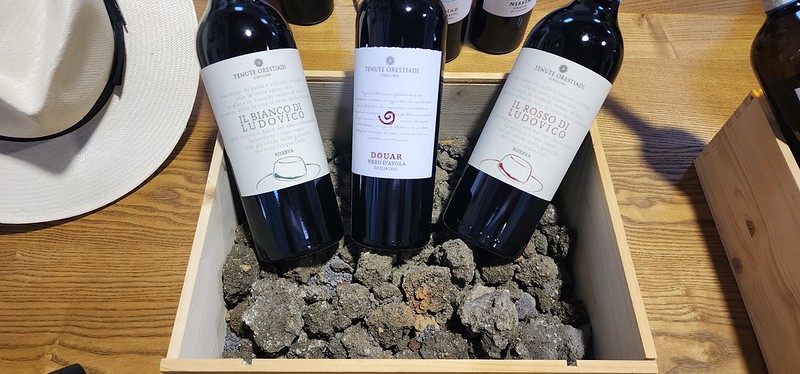
In 1998, nine of the original family farms joined together to form a winemaking cooperative in Gibellina called Cantine Ermes. Since its inception, it has expanded to 2350 growers, the largest cooperative in Sicily and Southern Italy. 345 acres are dedicated to the label Tenuta Orestiadi, the gem of the cooperative. Tenuta Orestiadi was born in 2008, connecting agriculture and contemporary art. The winery is in an old Baglio (Sicilian farm) and in the barrel cellar, barrels are topped by artwork by various artists. Across the road, the Museo delle Trame Mediterranee has one of the most important collections of contemporary and Mediterranean art in Italy.
The Province of Trapani
From Castellammare del Golfo, drive 40 minutes further west towards the city of Trapani to the Baglio Sorìa Resort & Wine Experience. An agricultural estate, Baglio Sorìa is located on a hillside overlooking 270 acres of vineyards. Baglio Sorìa Resort & Wine Experience was the first of five estates around Trapani purchased by the Di Gaetano family. Purchased in the 1980s, the Di Gaetano’s planted vineyards, cultivated olive trees, and restored old rural buildings.
The Baglio Sorìa is a former Sicilian farm where people worked and lived. Built in the seventeenth century, the Di Gaetano family renovated the building and built the Baglio Sorìa Resort & Wine Experience where guests can enjoy an eno-tourism experience. Baglio Sorìa has eleven rooms that look out over the Trapani countryside, Mount Erice, the salt pans, and the Egadi Islands. The resort includes a pool, a sun terrace, an outdoor fireplace, a restaurant, a wine shop and bar, and two wine tasting rooms.
Wine Tasting at Firriato
Via Trapani, 4, 91027 Paceco TP, Italy





The vineyards, food and wine experience you can expect when visiting Firriato. Images courtesy Allison Levine.
Baglio Sorìa is also the center of production in Trapani of Firriato wines. Firriato is an Italian term meaning enclosed, which relates to the term Clos used in reference to French estates. Firriato is a family-run business that includes seven estates representing the different soils that Sicily offers. They have vineyards in the hillsides in Trapani’s countryside, in the volcanic mountain of Etna, and near the sea on Favignana Island. It is in these different soils that Firriato grows many of the indigenous grapes of Sicily.
In the 1990s, Firriato planted its first Perricone vineyard, helping to revive this aromatic variety. Today they continue to research and recover other Sicilian varieties at their Borgo Guarini estate. Firriato’s vineyards and olive trees were all certified organic in 2010. In 2019, Firriato was certified Carbon Neutral and in 2021 they were certified Carbon Positive.
Wine Tasting at Casa Vinicola Fazio
Via Capitano Antonio Rizzo, 39, 91010 Fulgatore TP, Italy
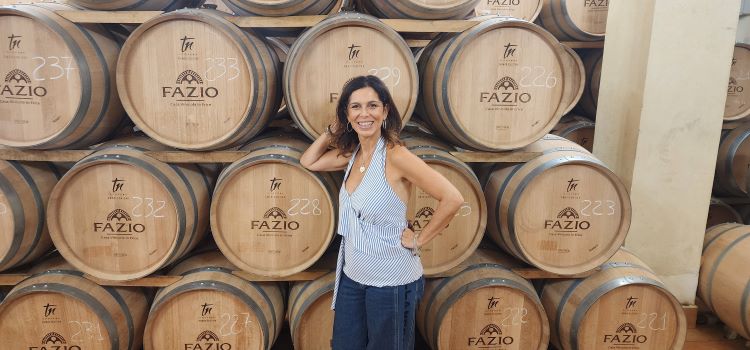
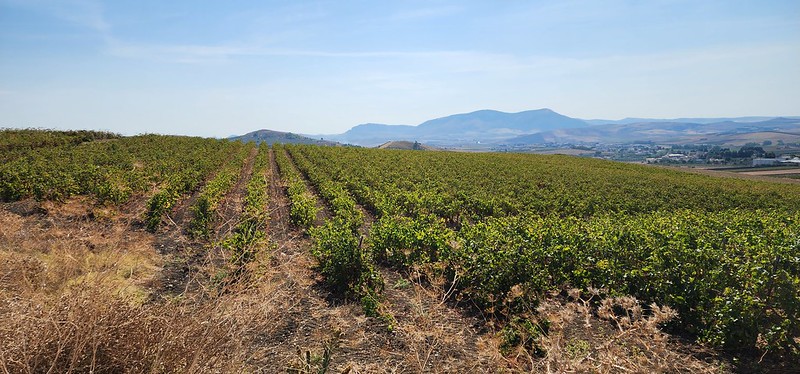
A fifteen-minute drive from Firriato is Casa Vinicola Fazio, located in the Erice DOC. Here Lily Ferro Fazio is the face of Fazio Wines. Lily, a former attorney, married Girolamo Fazio, whose grandparents established the company and grew grapes and grains. In the 1980s, Girolamo and his brother shifted their focus to quality in the vineyard and started to understand what grapes worked best in the Erice region. In addition to the native varieties of Nero d’Avola, Grillo, and Catarratto, they grow international varieties including Chardonnay, Syrah, and Müller Thurgau, a rare grape to find in Sicily.
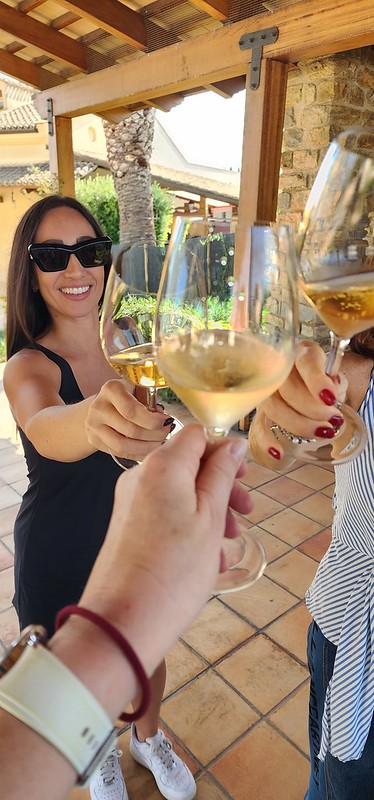
Fazio’s first vintage was in 1998 and Lily has been communicating about the history and culture of Erice and promoting the wines around the world ever since. Her beauty, charm, and passion are perfect to represent these elegant wines. Enjoy a personalized visit and tasting at Fazio showcasing the wines of Fazio with food. Visits are by appointment only.
More Wine Tasting Tour Options from Palermo
Wine Tasting for Small Groups in the Palermo Countryside
Take an intimate wine tasting journey in the serene Palermo countryside, meticulously curated by Panormus Autoservizi. This experience focuses on Baglio Di Pianetto winery, where you will explore both the lush vineyards and an innovative, sustainably designed wine cellar. This unique cellar, featuring a vertical structure, offers an enlightening path that gradually unveils the intricate secrets of wine production.
The highlight of this excursion is the tasting of five iconic wines, each a pure reflection of the values established by Count Paolo Marzotto since founding the company in 1997. These wines exemplify the winemaking prowess of Baglio di Pianetto, carefully selected from diverse terroirs renowned for their distinct characteristics: Palermo, Noto, and Etna. The tasting features an exclusively organic selection: the Viafrancia bianco Riserva (Viognier) Sicilia DOC, Fermata 125 Etna bianco DOC (Carricante), Fermata 125 Etna rosso DOC (Nerello Mascalese), Cembali (Nero d’Avola) Sicilia DOC, and Viafrancia red Reserve (Merlot – Cabernet Sauvignon) Sicily DOC.
This two-hour adventure includes not only the wine tasting but also a comfortable transport service. You will be accompanied by a professional, English-speaking driver/guide, who possesses extensive knowledge of the region and its wines. They will ensure your experience is both enriching and memorable, as you delve into the world of Sicilian viticulture amidst the picturesque backdrop of the Palermo countryside.
Book Your Palermo Wine Tour with Panormus Autoservizi
Wine Tasting Near Marsala
Located in the Province of Trapani, Marsala sits in the westernmost part of Sicily. It is known for the famous wine of the same name. Marsala DOC is a fortified wine made from the white grape varieties Grillo, Inzolia, Catarratto, and Damaschino. These wines can range from dry to sweet (more on how they’re made here). Marsala wine was well renowned around the world in the 1700s and 1800s and was traditionally served as an aperitif, but today is often used for cooking.
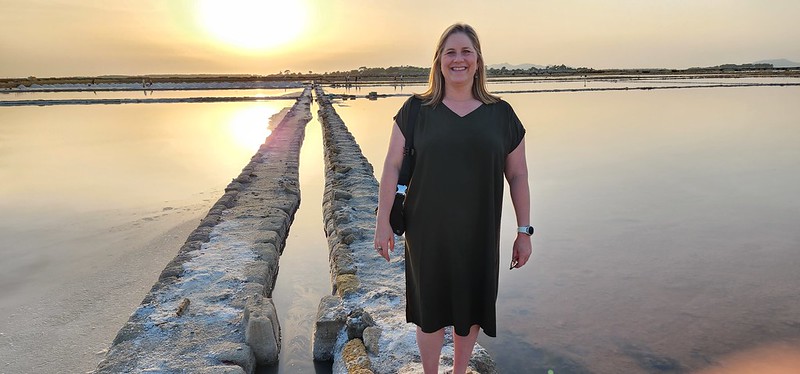
Marsala is also famous for its salt pans. The coastline from Marsala to Trapani is called the Salt Road in Sicily. Here is where some of Europe’s oldest salt marshes can be found. One of the two main areas of production is a few miles north of Marsala in the Stagnone Nature Reserve.
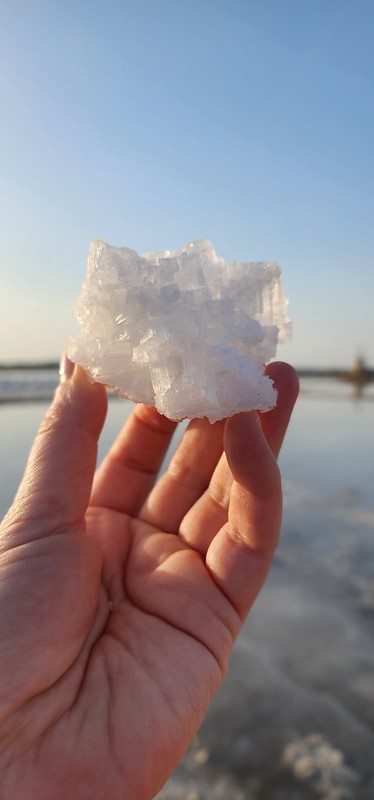
The Stagnone Nature Reserve includes four islands: Mothia, Santa Maria, Schola, and Isola Grande. Isola Grande, or “The Big Island,” is also known as “Long Island.” It is the largest and entirely accessible on foot thanks to salt tourism that was started in 2016. An old mill has been restored and offers visitors an introduction to the culture of salt, including a walk through the salt pans. Then enjoy a panoramic view and watch the sunset with an aperitivo and some food at Mamma Caura Ristorante.
Wine Tasting at Caruso e Minini
Via Salemi, 3, 91025 Marsala TP, Italy
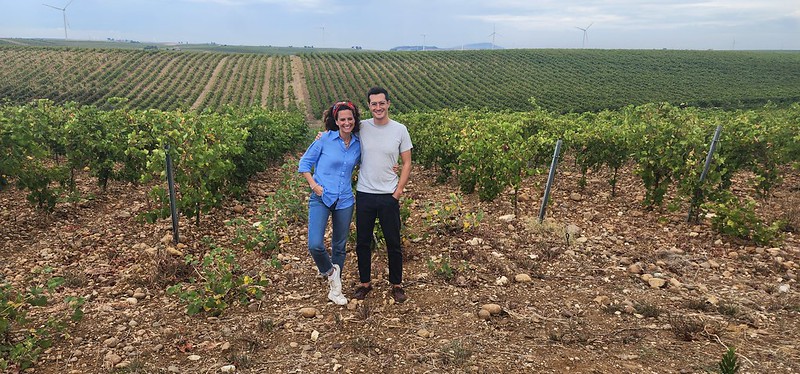
In the city of Marsala, some of the first wineries in Sicily were established. Today there are wineries across the island, but some wineries have kept their historic cellars in Marsala, and they are open to the public. One of these wineries is Caruso e Minini.
Nino Caruso began cultivating vineyards in the 20th century on the hills of Marsala. In 2002, Nino’s son Stefano partnered with Mario Minini from Piemonte. The goal was to start a winery that controlled the entire process to guarantee quality. Today the winery is run by third-generation sisters Giovanna and Rosanna Caruso, as well as Giovanna’s husband Andrea. They have 120 hectares in a hilly area of Marsala but are close to the sea resulting in a lot of wind.
The winery and tasting room are in a Baglio and date back to the 19th century. It is a large square courtyard surrounded by buildings where the wine is made. A visit to Caruso & Minini includes a walk in the cellar and a tasting of their wines. Caruso & Minini focuses on local grapes, such as Grillo, Catarratto, Nero d’Avola, and Perricone, as well as international varieties Cabernet Sauvignon, Merlot, and Syrah. The wine tasting is paired with local products, such as local cheeses and meats, caponata, olives, pizza, and more. Caruso & Minini is a winery with fresh energy, and their wines reflect that energy.
The Grapes of Western Sicily
Now that you have a sense of the vibe and experiences possible to craft a custom itinerary through some of the wine regions near Palermo, lets go beyond wine tourism briefly for the wine enthusiasts curious to know more about the grapes, wine styles and wine regions in the west.
Sicily as a whole is one of Italy’s largest wine-producing regions and is home to many indigenous varieties. On the western side, the primary white wine grapes are Grillo, Catarratto, and Inzolia. The primary red wine grapes are Nero d’Avola, Perricone, and Frappato.
- Grillo is known for fresh and aromatic white wines with floral and herbal notes.
- Catarratto, used for both still and fortified wines of Marsala, offers notes of lemon, apple, peach, dried flowers, and honey.
- Inzolia produces full-bodied, structured white wines.
- Nero d’Avola produces robust, full-bodied wines with notes of black cherry, licorice, and tobacco.
- Perricone, also called Pignatello, offers deep colors and bold flavors of red berries, herbs, and earth, and high acidity.
- Frappato produces light and fragrant red wines with notes of red berries and spice.
The DOC Wines of Western Sicily
While traveling in western Sicily, you’ll notice many wines will be labeled Sicilia DOC. Sicilia DOC covers the entire island and includes the production of red, white, and rosé wines, as well as sparkling and dessert wines. Other DOCs of Western Sicily include:
Monreale DOC covers red, rosé, and white wines from the area southwest of Palermo in the northwestern hills of Sicily. The area includes the province of Palermo and the three macro areas of Corleonese, Camporeale, and Valle dell Jato. Monreale Rosso is made from at least 50 percent Nero d’Avola and/or Perricone. Rosato must include 70 percent or more of Nerello Mascalese, Perricone, and/or Sangiovese. Monreale Bianco wines must have a minimum of 50 percent Catarratto and/or Inzolia.
Alcamo DOC includes white and red wines produced in nine different towns in the vicinity of Alcamo in the northwest of Sicily. These nine towns are Calatafimi, Castellammare del Golfo, Gibellina, Balestrate, Camporeale, Monreale, Partinico, San Cipirello, and San Giuseppe Jato. Alcamo Biano must have at least 60 percent Catarratto and Alcamo Rosso must have at least 60 percent Nero d’Avola.
Erice DOC is in the province of Trapani and includes red, white, and sweet styles. Erice Rosso must have a minimum of 60 percent Nero D’Avola and Erice Biano must have at least 60 percent Catarratto. Single-variety wines with a minimum of 85 percent of one grape are permitted.
Marsala DOC, a fortified wine produced in the region surrounding the city of Marsala in western Sicily, has a rich heritage dating back to the 18th century. This versatile wine, available in dry, semi-dry, and sweet varieties, is crafted from a selection of up to ten grape types, including Grillo, Inzolia, Catarratto, Perricone, Nerello Mascalese, Damaschino, and Nero d’Avola. Each variety contributes to the distinct flavors and aromas of Marsala, ranging from nutty and woody notes in the dry versions to sweeter, more complex profiles in the sweet varieties. A hallmark of Marsala DOC is its unique aging process, often employing the solera method, which imparts depth and complexity to the wine. This method involves fractional blending in such a way that the finished product is a mixture of ages, with the average age gradually increasing as the process continues over many years. Marsala DOC wines are also a versatile culinary component, enhancing a wide range of dishes from savory sauces to exquisite desserts.
Pin This Palermo Winery Guide for Later on Pinterest
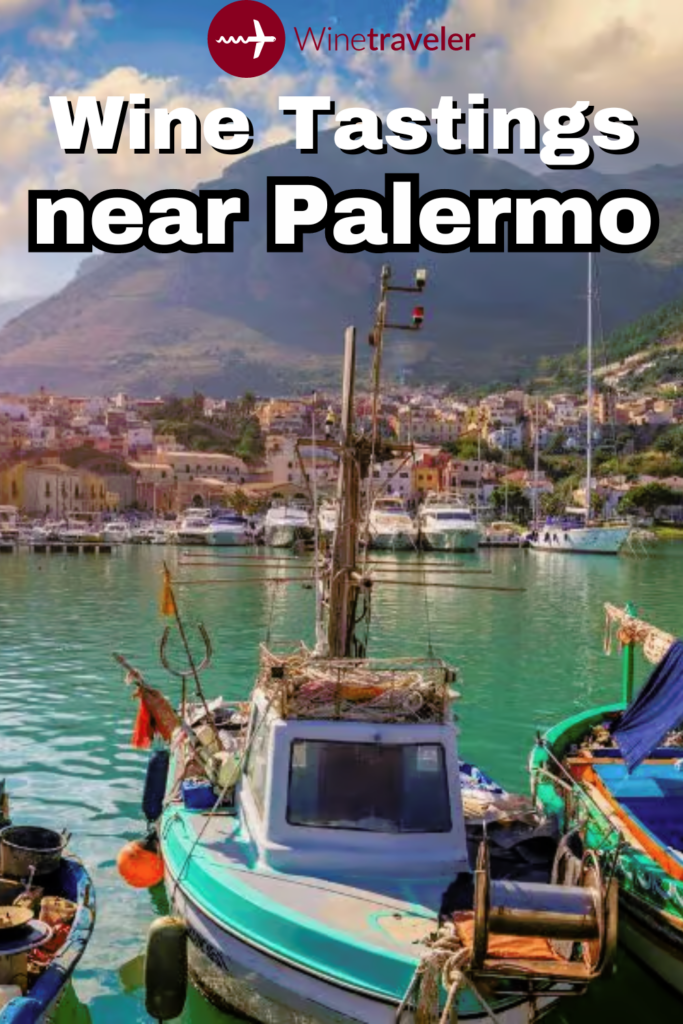
You are reading “How to Go Wine Tasting Near Palermo, Marsala & Beyond“: Back To Top
wineries in Palermo, wineries in Marsala, wineries near me, things to do in Palermo: best Italian wineries and tours
If you enjoyed this guide, consider joining the Facebook Group to interact with other Winetravelers and for wine travel inspiration around the world. Be sure to follow us on both Twitter and Instagram to stay up to date with our trending content.
